Data Story: Certificates of Occupancy in Albemarle County
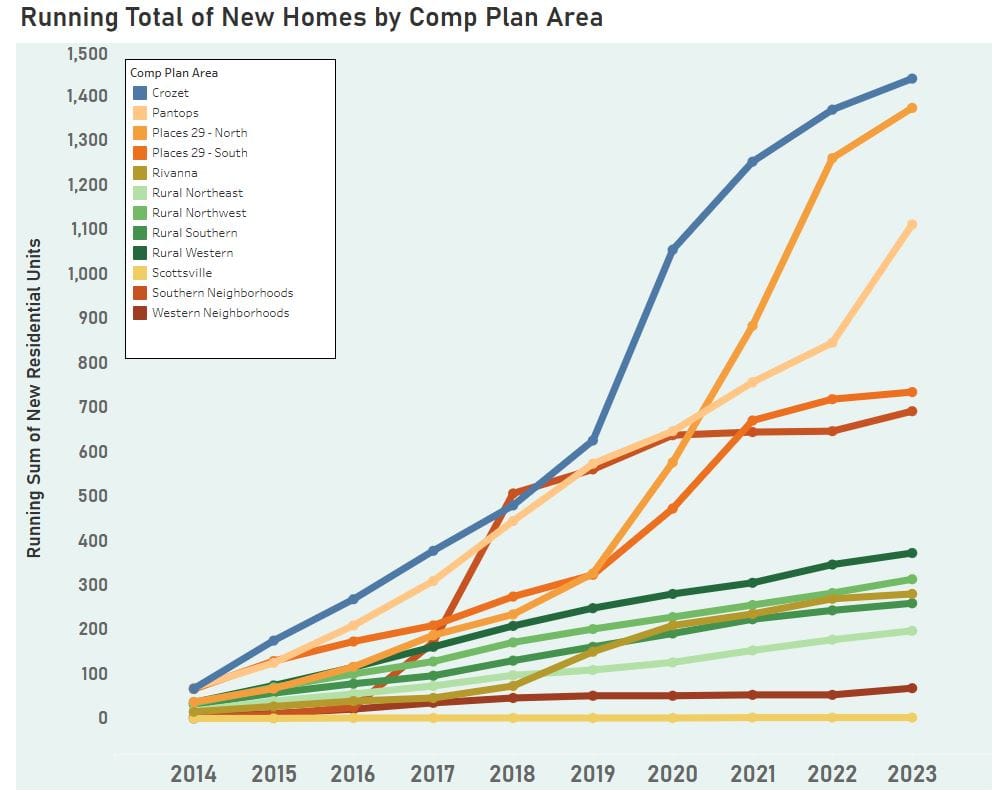
This post uses a Tableau data story I created. The data story is linked throughout, but you can follow along with it here.
How many new homes have been built in Albemarle County in the last decade?
There's a lot of ways to answer that question - a lot of tools, reports, census data, whatever. I took one particular avenue: the Certification of Occupancy annual reports from the Albemarle County website. These reports show the numbers of certificates of occupancy issued in a given year, for which type of home, by different locational metrics. Fortunately, numbers from 2007-2023 are available right there, for your viewing pleasure, in convenient little PDFs broken out by comp plan area, magisterial district, school district, etc. Unfortunately, the data from 2024 isn't up yet, and those convenient little PDFs are kind of a pain to turn into usable data tables.
Like a genius, I went ahead and data-entry'd the last ten years of data by magisterial district and comp plan area. That data is now available in some tables in a google sheets document, for those with similarly insane interests.
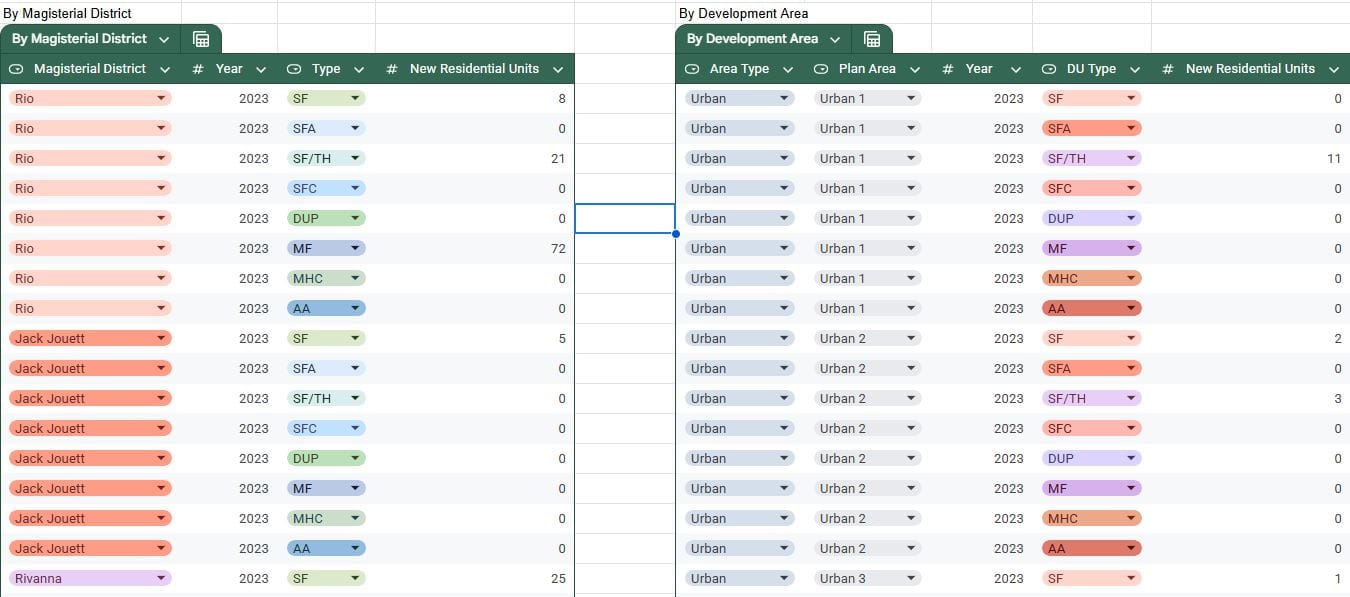
Next: to Tableau, to visualize some of this and see what signal might be hiding in the noise.
I was able to answer my initial question pretty quickly: 6,839 homes received a CO in Albemarle between 2014-2023. There's been a decline since the peak in 2020, which shouldn't be too much of a surprise: on the macro level, we know the pandemic slowed down construction considerably, and that means we'd see fewer COs in the years following the onset of the pandemic.
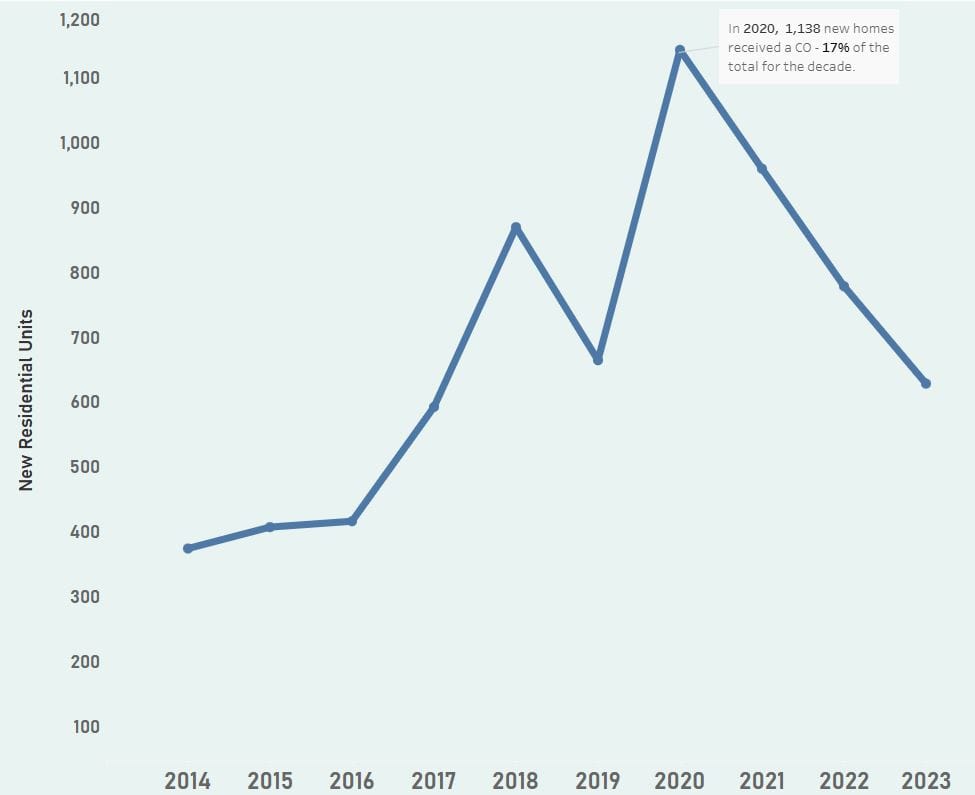
Now, I live in Crozet. Something you hear a lot around Crozet is "we've done more than our fair share of building!" There's a perception that Crozet has built more than other development areas in Albemarle County. I wanted to test this, and I found - hey presto, it's basically true! (By this specific metric). Running totals of new COs for each comp plan area 2014-2023 show Crozet in the lead, followed closely by Places29-North (think Hollymead, Piney Mountain - the northern Rt 29 corridor). I know these oranges and greens look pretty similar; I recommend visiting the Tableau story to click on the lines and differentiate some stuff.
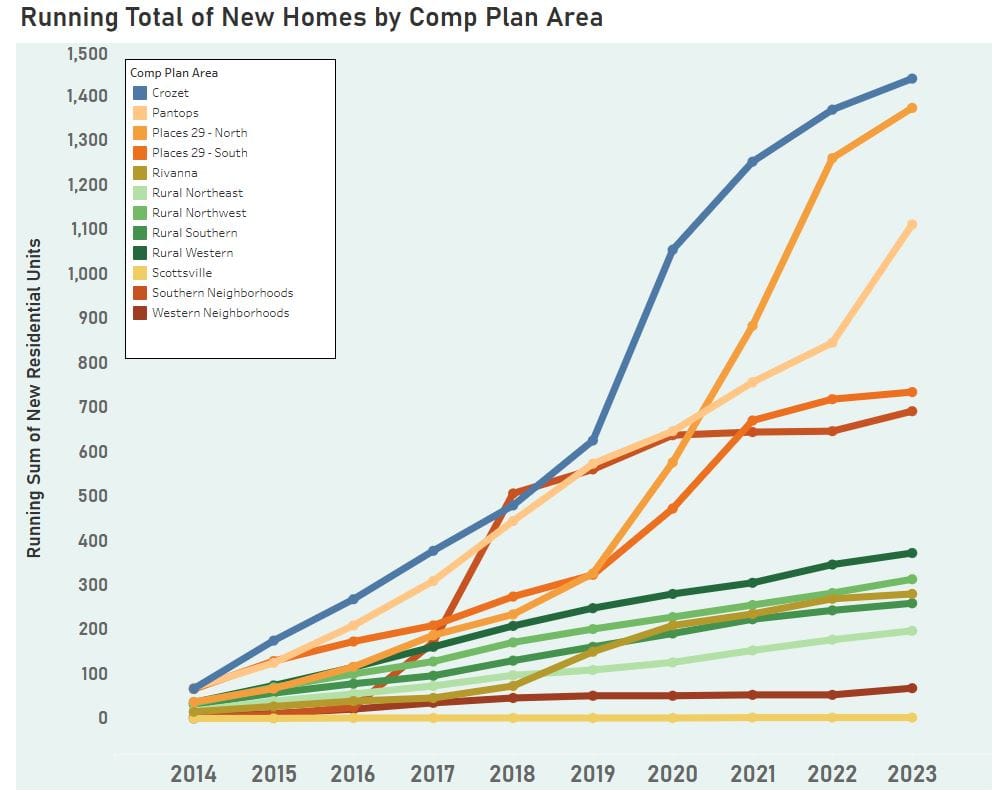
Some other things that stood out to me here: Places29 South and the Southern Neighborhoods (that's 5th and Avon, to those who know) are solidly middle-of-the-pack, with relatively slow rates of recent development. The rural areas (shown in shades of green) have a very steady rate of growth, about 100 COs/year across all four rural areas. The Western neighborhoods, meanwhile, have seen very little development, squeaking around down at the bottom with Scottsville, well below the rural areas.
But what types of homes are we talking about? McMansions? Granny flats?

Hey look at that: single-family detached homes are the clear leader in COs across the last decade. 42% of all COs were for single-family detached homes. In this data, I grouped together townhouses, condos, duplexes, and single-family attached homes into one parent category, "Single-Family Attached." You can see from the slowing curve of the SFD line that single-family detached development has slowed down in the last few years, while multi-family homes climb faster.
For Crozet in particular, a steady supply of single-family homes drove development in all but two years: 2020, when 274 multi-family units came online (I think that's the Summit at Old Trail, but that's off the dome so take it with a grain of salt), and 2023, when single-family detached COs plummeted from 76 to 15.

I also wanted to investigate a claim/belief that's been bubbling in one shape or another: "stalling development in the development areas shunts growth to the rural areas!" The theory here - one that I'm not really fully testing in this data, so don't get too excited - is that the process of discretionary review in the development areas means that those with the money and inclination will instead just build by-right in the rural areas, creating a steady trickle of large single-family detached homes in the rural areas of Albemarle County.
Did I find that? Kinda.
First: percent of COs by Rural and Development:

Rural COs made up an average of 19% of COs/year; that shrank to 9% in 2020, and is slowly returning to pre-pandemic levels. But this chart only tells part of the story. After all - in the rural areas, you're far less likely to see multi-family development, or townhome/condo/duplex development. By-right development is more likely to be single-family detached. So let's just compare single-family detached numbers in and out of the rural areas:

Oh well that's interesting.
There's a lot of ways to think about this data and what it could mean, and all of those ways require more testing to actually prove.
One way to slice it: the rural areas see about the same number of homes built every year - it's about 100 - no matter what. Rural area development is steady regardless of economic conditions.
Another way to slice it: the factors that lead to a decrease in single-family construction in the development areas don't impact single-family construction in the rural areas. If the dev. areas are running out of parcels to build on, the rural areas aren't. If the dev. areas are seeing a decrease in demand for single-family detached housing, the rural areas aren't. If, say, increased costs are strangling new housing in the development areas, that same effect isn't present in the rural areas.
Someone could take that and run with it as "the wealthy people building homes in the rural areas of Albemarle County are insulated from the economic pressures that stunt the growth of multi-family/missing middle housing." I don't know that I can prove that with this data alone, or that I would run that far.
But I will say: Redfin's housing data (a great source, btw! Everyone should be aware of this!) lets us take a good look at the median sale price for a single-family residence in Albemarle County over this same timeframe (2014-2023).

In January 2014, the median price was $342,000. In December 2023, it was $660,000 - just under double the median price ten years earlier. Now, by the way? In June 2025, the most recent data on that chart? $685,000. It peaked at $750k in November of 2024.
So these single-family detached COs represent homes somewhere in that ballpark. As the supply wobbles, declines, and plateaus, price has climbed up and up and up.
One last takeaway, to bring it back to the top. Crozet and Places29 North lead the county in COs over the last decade. Looking at this cropped screenshot of a map of AC development areas, anything stand out to you about those two?
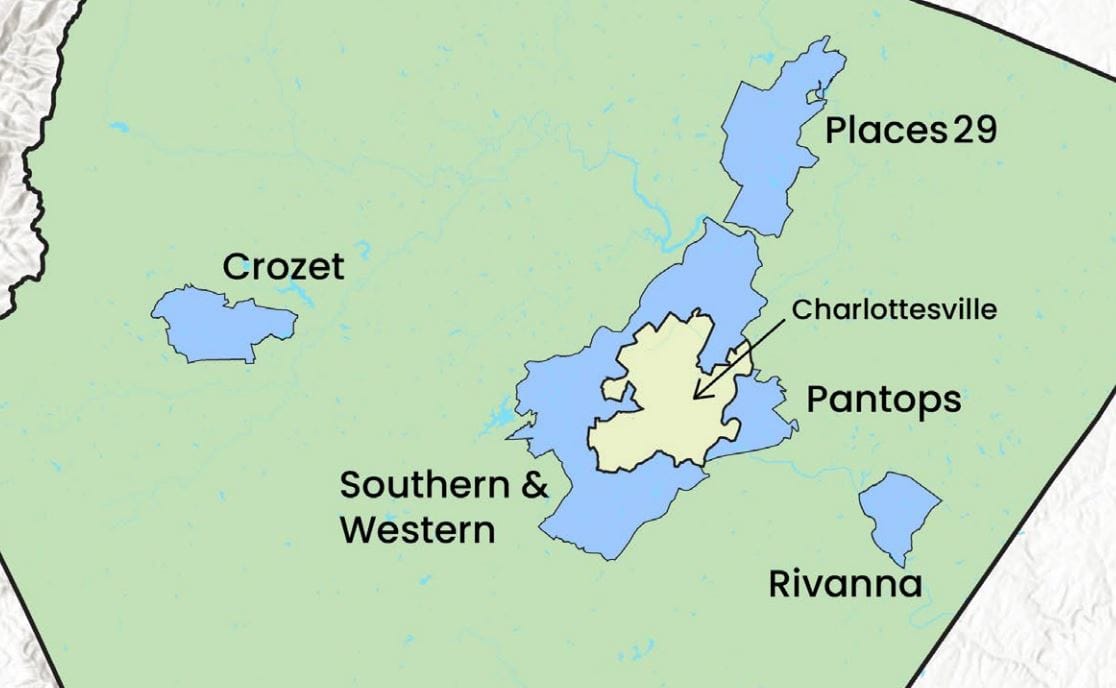
These two development areas are the furthest out - save maybe for Village of Rivanna, a topic for another blog post. 41% of COs in the last decade have been in Crozet or the Hollymead/Piney Mountain area up there. Hollymead/Piney Mountain at least have NGIC and some other employment centers, but it's still likely true that a lot of folks in both Crozet and north 29 work in and commute to Charlottesville (or at least the urban ring of Cville).
For me, this raises the bigger question: are the development areas working? From just looking at this data, the answer seems to be "sort of." Rural construction is still relatively slow, and doesn't appear to be meaningfully increasing, even if it is isolated from the factors that stall development in the growth areas. Meanwhile, large multifamily projects continue to provide boosts to the number of homes available in the development areas. But most of the development area growth is in the furthest-flung development areas, which still rely on Charlottesville/the urban ring for jobs/services/etc. One of the major benefits of dense housing development is bringing people closer to their jobs, their doctors, their food, all of it. If we're developing densely a 30-minute drive away from life, then maybe we're missing out on the benefits of dense development. Crozet needs more employment centers, and the development areas in the urban ring need more housing.
Final thoughts:
- I hope the 2024 data goes up soon. I'd like to plug that in and see how things shake out.
- The Development Dashboard is currently (8/5/25) down, but there's a nice PDF with pipeline totals. Of note there:
- Hollymead and Piney Mountain have a combined 5,433 approved unbuilt residential units, with another 969 under review. Crozet has 1,516, although I believe a good chunk of that is Old Trail, which is likely to come in way under that number.
- Neighborhood 5 (Southern, in my charts above) is about to balloon - a combined 3,060 homes approved or under review. Southwood!
- Neighborhoods 1 and 2 (Places 29 South) have 1,553 approved, with another ~1,100 under review.
- Will all these approved units get realized? Not necessarily, and not necessarily soon.
- I'd love to know how many of the COs in this data came from rezonings, and how many were built by-right.
- The most recent Land Use Buildout Analysis provides some insight on the land still available to build on, which is important context for where homes get built in Albemarle County. Of note is an often-bandied-about stat: between 2016 and 2021, across 20 residential applications, the total number of units approved was approximately 58% of the max recommended per the Comp Plan.
- The buildout analysis also gave some estimates of 20-year demand for between 11,500 and 13,500 homes based on population trends, while estimating a max buildout of between 15,493 and 24,133 homes without changing development area boundaries. It's super interesting! Worth a read if you care about this stuff! And also worth considering: the sheer number of people living in an area is only one way to describe population, and the number of homes is only one way to describe homes. There's a big difference, for example, between 10,000 McMansions and 10,000 studio apartments - a big difference on who can afford to live there, for example.
And hey, don't forget: check out the Tableau public version of this post! There's a little slide in there (slide 4) that has some interactive elements (ooh, ahh). Link here: https://public.tableau.com/app/profile/michael.monaco1474/viz/NewHomesinAlbemarleCounty/COStory#1

